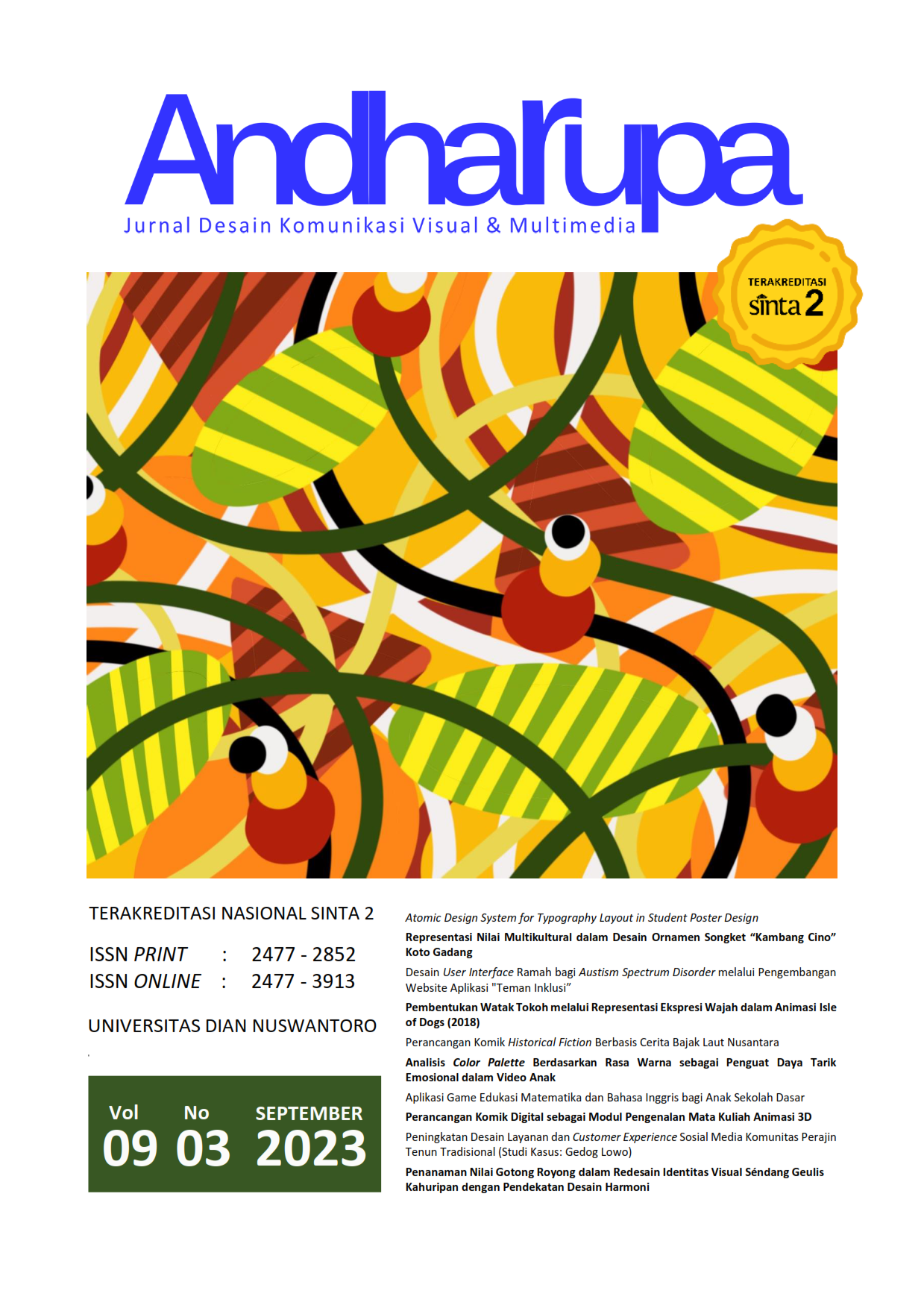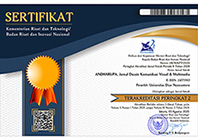Desain User Interface Ramah bagi Austism Spectrum Disorder melalui Pengembangan Website Aplikasi "Teman Inklusi”
DOI:
https://doi.org/10.33633/andharupa.v9i03.6966Abstract
Orang dengan Autism Spectrum Disorder (ASD) menghadapi masalah yang berbeda ketika berinteraksi dengan informasi di situs web. Penelitian ini menginvestigasi rekomendasi desain User Interface (UI) yang dapat diakses untuk ASD melalui panduan UI ramah ASD serta pedoman easy to read information untuk orang dengan gangguan belajar. Penelitian ini berjenis kualitatif, dan mengikuti lima tahap design thinking: berempati, definisi masalah, ideasi, prototipe, dan pengujian. Hasil penelitian ini adalah rancangan User Interface "Teman Inklusi" yaitu aplikasi situs web pembelajaran assitif untuk ASD. Hasil penelitian merekomendasikan bahwa saat membuat situs web untuk ASD, desainer harus dengan seksama mengatur variabel presentasi dan interaksi UI. Komponen UI harus memiliki lebih sedikit animasi, lebih sedikit jenis dan sedikit perbedaan ukuran font, lebih sedikit gambar kompleks, lebih banyak area putih, dan pembahasan suatu topik yang kompleks dibuat dengan penyajian informasi disertai contoh yang disampaikan secara visual dan audio. Dengan mengimplentasikan prinsip – prinsip UI ramah ASD dan pedoman easy to read information untuk orang dengan gangguan belajar, website aplikasi Teman Inklusi berhasil mendapatkan rata-rata penilaian 96 (dari skala 1-100) dari uji coba pada 9 mahasiswa ASD. Penelitian ini berkontribusi pada pengembangan tentang prinsip-prinsip User Interface untuk mengembangkan situs web ramah autisme untuk konteks digital. Kata Kunci: design thinking, User Interface, web ramah autisme AbstractPeople with Autism Spectrum Disorder (ASD) encounter distinct issues when interacting with information on websites. We investigate the requirements for developing an accessible User Interface for users with autism spectrum disorders (ASD) as well as the rules for producing easy-to-read material for people with learning difficulties in this work. The research is qualitative, and it follows the five stages of design thinking: empathize, define, ideate, prototype, and test. The study's outcome is the User Interface of "Teman Inklusi," a learning assistive website application for people with autism spectrum disorder. According to the study, while creating a website for ASD, designers should carefully arrange the UI presentation and interaction. It must have less animation, fewer font types and sizes, fewer complex pictures, more white space, and an example that is conveyed both visually and audibly when discussing complex topics. By implementing the UI for ASD and easy to read and the guidelines for the production of easy-to-read information for people with learning disabilities, the proposed website application "Teman Inklusi" got an average score of 96 from scale 1–100 from user Testing with 9 ASD. This research contributes to a better knowledge of the User Interface principles for developing autism-friendly websites in the digital world. Keywords: austism spectrum disorder friendly website, design thinking, User InterfaceReferences
Brooke, J. (1995). SUS: A “Quick and Dirty” Usability Scale. Usability Evaluation In Industry, July, 207–212.
Chithra, P., & Henila, M. (2019). User Interface Design Issues for Easy and Efficient Human Computer Interaction: An Explanatory Approach. International Journal of Computer Sciences and Engineering, 6(10), 628–632.
Freyhoff, G., Hess, G., Kerr, L., Menzel, E., Tronbacke, B., & Veken, K. Van Der. (1998). Make it Simple European Guidelines for the Production of Easy-to-Read Information for People with Learning Disability (Issue June). http://www.inclusion-europe.org/documents/99.pdf
Gutierrez, M., Mendez, M., Centeno, B., & Osorio, L. (2018). The Styles Visual, Auditory, Kinesthetic And Competences In The Classroom. International Journal of Recent Scientific Research, 10(December), 30693–30695.
Ismail, U. U., & Rozzani, ; Rusyaizila Ramli; Nabilah. (2021). User Experience / User Interface (UX/UI) Design for Autistic Spectrum Disorder (ASD) Color Based Emotion Detection System: A Review. 2021 IEEE International Conference on Automatic Control & Intelligent Systems (I2CACI).
Moran, K. (2019). Usability Testing 101. https://www.nngroup.com/articles/usability-Testing-101/
National Autism Resources. (2023). The Picture Exchange Communication System (PECS). https://nationalautismresources.com/the-picture-exchange-communication-system-pecs/
Pavlov, N. (2014). User Interface for People with Autism Spectrum Disorders. Journal of Software Engineering and Applications, 07(02), 128–134.
Platner, H. (2015). An introduction to Design thinking. Iinstitute of Design at Stanford.
Sautter, R. A., & LeBlanc, L. A. (2006). Empirical Applications of Skinner’s Analysis of Verbal Behavior with Humans. The Analysis of Verbal Behavior, 22(1), 35–48.
Utami, T. S. D. (2018). Pemerolehan Bentuk-Bentuk Kalimat Anak Autis Yayasan Pelita Hati Palembang. Jurnal Didascein, 3(2), 709–715.
Valencia, K., Rusu, C., & Botella, F. (2021). User experience factors for people with autism spectrum disorder. Applied Sciences (Switzerland), 11(21).
Yu, B., Murrietta, M., Horacek, A., & Drew, J. (2018). A Survey of Autism Spectrum Disorder Friendly Websites. SMU Data Science Review, 1(2).
Downloads
Published
Issue
Section
License
Authors who publish with this journal agree to the following terms:
- Authors retain copyright and grant the journal right of first publication with the work simultaneously licensed under a Creative Commons Attribution License that allows others to share the work with an acknowledgment of the work's authorship and initial publication in this journal.
- Authors are able to enter into separate, additional contractual arrangements for the non-exclusive distribution of the journal's published version of the work (e.g., post it to an institutional repository or publish it in a book), with an acknowledgment of its initial publication in this journal.
- Authors are permitted and encouraged to post their work online (e.g., in institutional repositories or on their website) prior to and during the submission process, as it can lead to productive exchanges, as well as earlier and greater citation of published work (See The Effect of Open Access).















